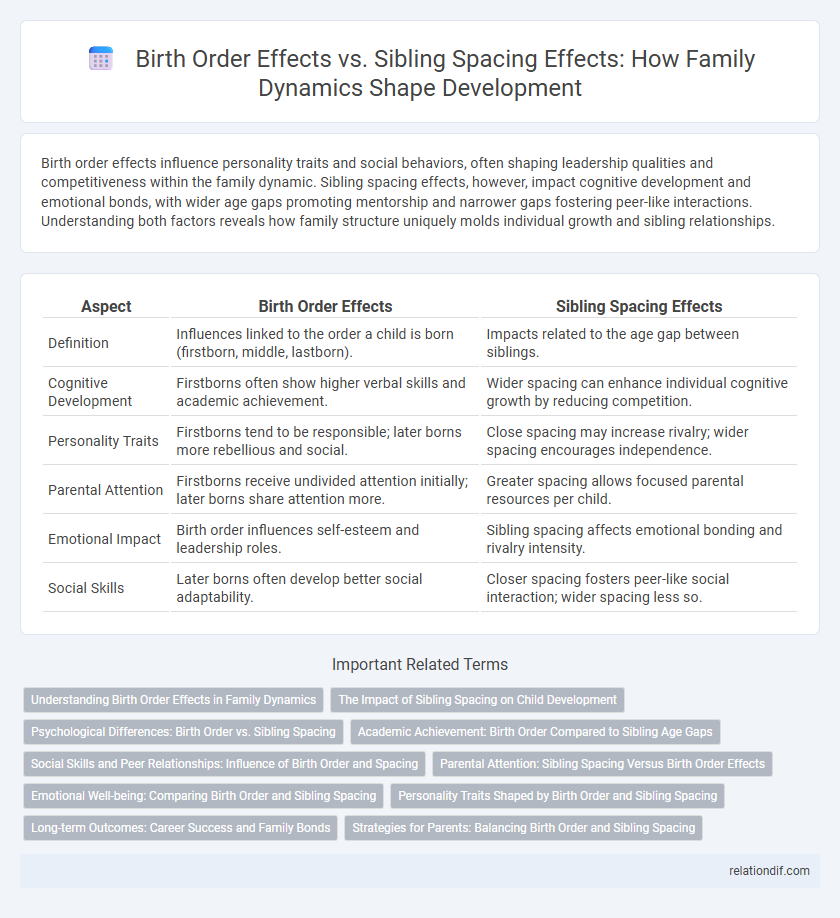Birth order effects influence personality traits and social behaviors, often shaping leadership qualities and competitiveness within the family dynamic. Sibling spacing effects, however, impact cognitive development and emotional bonds, with wider age gaps promoting mentorship and narrower gaps fostering peer-like interactions. Understanding both factors reveals how family structure uniquely molds individual growth and sibling relationships.
Table of Comparison
| Aspect | Birth Order Effects | Sibling Spacing Effects |
|---|---|---|
| Definition | Influences linked to the order a child is born (firstborn, middle, lastborn). | Impacts related to the age gap between siblings. |
| Cognitive Development | Firstborns often show higher verbal skills and academic achievement. | Wider spacing can enhance individual cognitive growth by reducing competition. |
| Personality Traits | Firstborns tend to be responsible; later borns more rebellious and social. | Close spacing may increase rivalry; wider spacing encourages independence. |
| Parental Attention | Firstborns receive undivided attention initially; later borns share attention more. | Greater spacing allows focused parental resources per child. |
| Emotional Impact | Birth order influences self-esteem and leadership roles. | Sibling spacing affects emotional bonding and rivalry intensity. |
| Social Skills | Later borns often develop better social adaptability. | Closer spacing fosters peer-like social interaction; wider spacing less so. |
Understanding Birth Order Effects in Family Dynamics
Birth order influences personality traits, leadership tendencies, and sibling relationships within families, often shaping individual roles and expectations. Sibling spacing affects these dynamics by altering competition levels and parental attention, impacting emotional development and social behavior. Recognizing how birth order and spacing interact provides deeper insight into family dynamics and child development outcomes.
The Impact of Sibling Spacing on Child Development
Sibling spacing significantly influences child development by shaping the quality of sibling interactions and parental resource allocation. Wider age gaps often allow older siblings to serve as role models, fostering cognitive and emotional growth, while closer spacing can enhance social skills through frequent peer-like play. Research indicates that optimal spacing balances competitive dynamics with support, promoting healthier psychological adjustment and academic outcomes.
Psychological Differences: Birth Order vs. Sibling Spacing
Psychological differences between siblings are influenced by both birth order and sibling spacing, with birth order often shaping personality traits such as leadership, responsibility, or rebellion. Sibling spacing affects emotional bonding and rivalry intensity, where closely spaced siblings may experience more competition, while wider spacing can lead to individualized attention and unique developmental paths. Research indicates that the interplay between these factors contributes significantly to variations in self-esteem, social skills, and cognitive development within families.
Academic Achievement: Birth Order Compared to Sibling Age Gaps
Research indicates that birth order significantly influences academic achievement, with firstborn children often outperforming their younger siblings due to increased parental attention and expectations. Sibling age gaps also impact educational outcomes, as larger intervals can reduce sibling rivalry and allow more individualized support, positively affecting achievement. Comparing both factors, birth order tends to have a stronger correlation with academic performance than sibling age spacing, although the combined effect varies with family dynamics and resources.
Social Skills and Peer Relationships: Influence of Birth Order and Spacing
Birth order significantly impacts social skills development, with firstborns often displaying leadership qualities while later-born siblings tend to be more socially adaptive in peer relationships. Sibling spacing also plays a crucial role; closely spaced siblings typically develop stronger interpersonal skills and cooperative behaviors due to frequent interaction, whereas widely spaced siblings may experience more independent social growth. Research shows that both birth order and sibling spacing uniquely shape children's abilities to navigate social environments and form peer connections.
Parental Attention: Sibling Spacing Versus Birth Order Effects
Parental attention varies significantly between birth order and sibling spacing, influencing child development uniquely. Firstborns often receive concentrated attention initially, but closely spaced siblings compete more directly for parental resources, potentially diluting individualized care. Wider sibling spacing allows parents to allocate focused time and support to each child, mitigating adverse effects commonly attributed to birth order.
Emotional Well-being: Comparing Birth Order and Sibling Spacing
Emotional well-being in children is influenced by birth order, with firstborns often exhibiting higher responsibility and leadership traits, while later-borns may develop greater social adaptability. Sibling spacing also plays a critical role, as wider age gaps tend to reduce sibling rivalry and emotional stress, promoting individual attention from parents. Research shows that optimal emotional health arises when birth order effects are balanced by strategic sibling spacing.
Personality Traits Shaped by Birth Order and Sibling Spacing
Birth order significantly influences personality traits, with firstborns often exhibiting leadership and conscientiousness, middle children developing strong social skills, and lastborns tending towards creativity and agreeableness. Sibling spacing also affects personality development; wider age gaps can result in more distinct individual identities, while closely spaced siblings may experience increased rivalry and shared behavioral patterns. Research suggests that the interaction between birth order and sibling spacing shapes traits such as self-esteem, independence, and social competence throughout childhood and adulthood.
Long-term Outcomes: Career Success and Family Bonds
Birth order influences long-term career success by shaping personality traits; firstborns often exhibit leadership and responsibility, while later-born siblings may develop creativity and social skills. Sibling spacing affects family bonds, with closely spaced siblings typically fostering stronger emotional connections due to shared experiences, whereas wider spacing can lead to more independence but potentially weaker bonds. Both factors interact to impact individual development and relationship dynamics within the family system.
Strategies for Parents: Balancing Birth Order and Sibling Spacing
Parents can optimize child development by carefully balancing birth order and sibling spacing, recognizing that closely spaced siblings often engage in more intense rivalry while wider spacing may promote individual attention and resource allocation. Implementing strategies such as staggered milestones and personalized parenting approaches helps address the unique needs that arise from both birth order dynamics and sibling age gaps. Emphasizing communication and emotional support tailored to each child's position and spacing enhances family harmony and promotes healthy sibling relationships.
birth order effects vs sibling spacing effects Infographic

 relationdif.com
relationdif.com